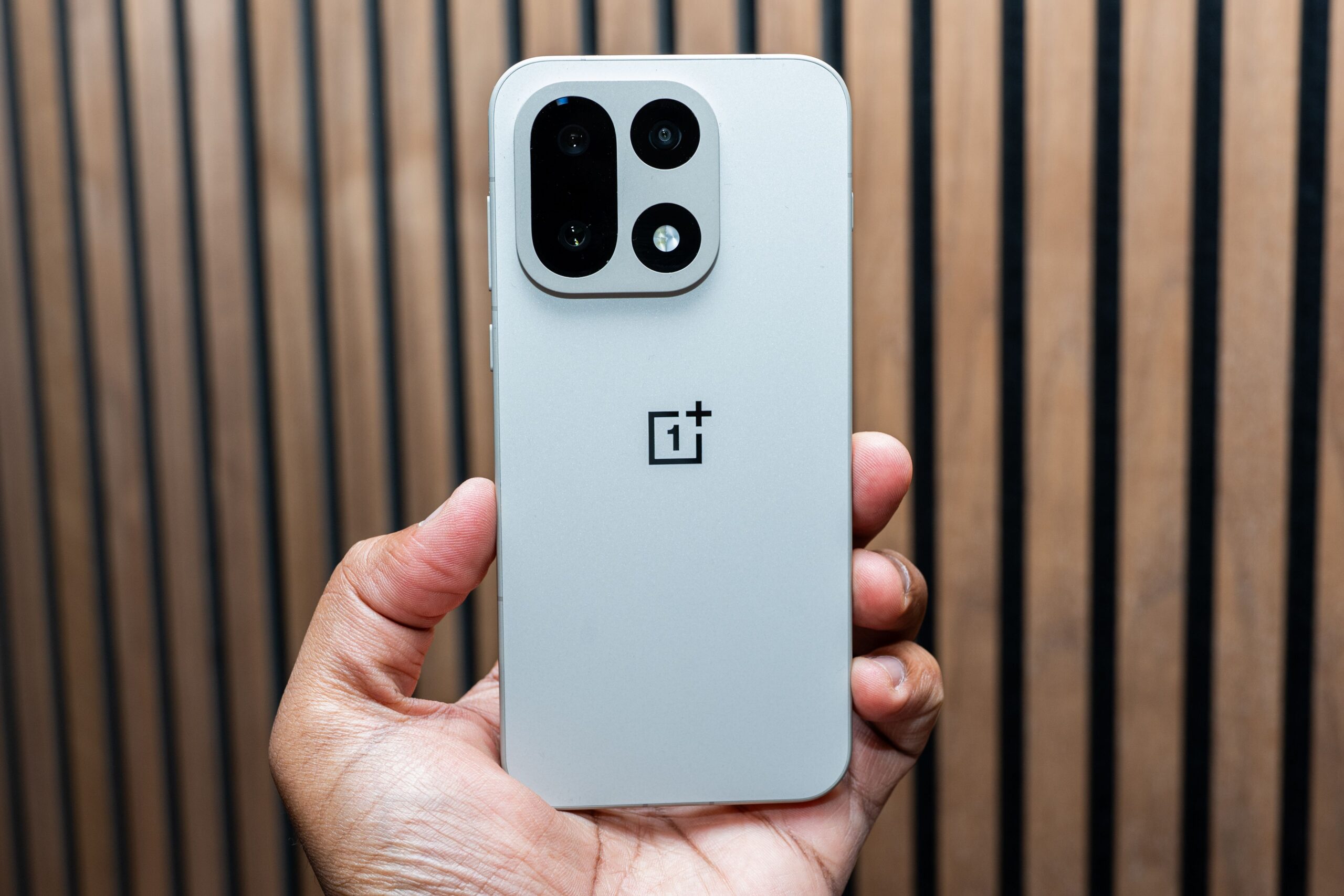OnePlus has been churning out Android smartphones for over a decade, yet it still feels like the company is fighting an uphill battle to get a foothold in the US. There were a few years when it felt like it was ready to sit just below the likes of Samsung and Apple, but those days are long gone—it’s now even behind Motorola and Google in market share.
Perhaps a new phone with a fresh look can help turn things around. The OnePlus 15 enjoys a redesign that nixes the giant, round camera module in favor of a square camera bump we’re all too familiar with. The unique marble-like patterns on the back are no more; instead, say hello to flat colors: Infinite Black, Sand Storm, and Ultra Violet. It doesn’t look or feel like a OnePlus, but that might not matter. I do have to point out that a year hasn’t even passed since I reviewed the OnePlus 13 (there is no OnePlus 14 due to Chinese cultural superstitions around the number). OnePlus moved up its Android phone launch to be one of the first with Qualcomm’s new flagship processor.
The OnePlus 15 starts at $900, though if you want a color other than black and with faster RAM, you’ll need to pay $1,000 (just like its predecessor). Preorders were supposed to kick off today, but the US government shutdown put a wrinkle in those plans. The phone hasn’t been certified by the FCC yet, but with the shutdown nearing its end, expect the OnePlus 15 to be available in the US very soon. It’ll work on every major US carrier.
Super Cell

Photograph: Julian Chokkattu
The OnePlus 15 impresses in two areas. First, and arguably the most important: battery life. This is the only smartphone sold in the US with a massive 7,300-mAh silicon-carbon battery. For context, the Samsung Galaxy S25 Ultra has a 5,000-mAh cell. This massive leap in size means the OnePlus 15 has enough in the tank to easily last two days on a single charge. I exclusively charged it every other day after more than a week of testing.
On days with light use, I have 70 percent left by bedtime. When I spent more time on the phone, using it for music streaming, navigation, and Instagram Reels-ing, I often ended with around 60 or 50 percent. I’d leave it on my nightstand without bothering to plug it in, a refreshing change of pace. Over the course of two days, I hit an amazing 10 and a half hours of screen-on time.
This might be the best battery life on a flagship smartphone today in the US, especially when you pair it with the incredibly fast recharge times. OnePlus remains one of the only companies to include a charger in the box—mostly because it’s the only way to take advantage of its SuperVooc fast-charging technology. I was able to ramp from 15 to 80 percent in 30 minutes (50 percent in 15 minutes). It’s hard to worry about a dead phone if you don’t mind keeping the bulky charger on your person (is a folding prong too much of an ask?).
But there’s always a compromise somewhere. If you’re a fan of wireless charging and are especially interested in Qi2 smartphones that use magnets (like Apple’s MagSafe) for more convenient and faster charging, you’ll be disappointed here. The OnePlus 15 supports wireless charging, but only the standard Qi technology. OnePlus is selling magnetic cases as a salve, but unlike Samsung’s current crop of top-end phones, this doesn’t even turn it into a Qi2 Ready phone. It will only charge at slow Qi wireless charging speeds. (You can buy OnePlus’ proprietary wireless charger to fast-charge, but that’s a separate purchase, and that wireless charger will only recharge select OnePlus devices quickly.)
The beefy battery and super-fast wired charging may outshine the lackluster wireless charging, but now it’s time to talk about the second most impressive feat of the OnePlus 15: performance.
Power Play

Photograph: Julian Chokkattu
This is the first smartphone in the US to employ Qualcomm’s Snapdragon 8 Elite Gen 5, a processor we’ll see in most high-end Android phones in 2026. The benchmark numbers are excellent. In a Geekbench 6 test, the OnePlus 15 is officially the first phone to pass 10,000 in multi-core CPU performance, even besting the iPhone 17 Pro Max. However, the iPhone still had a slight leg up in single-core performance (it’s also generally more efficient).
Naturally, moving around the operating system and running all the usual apps and games is child’s play. Everything feels wonderfully slick and snappy. The best way to be impressed by those benchmark numbers is to run some demanding mobile games. Genshin Impact still causes some high-end phones to struggle when all graphical settings are maxed out, but for the first time in my experience with Android phones, performance on the OnePlus 15 seemed flawless. That’s with the highest settings in the game, and also maxing out fidelity using OnePlus’ Game Mode. The game looks fantastic, and runs beautifully, consistently hitting 60 frames per second. Even after more than an hour of gameplay, the phone didn’t feel uncomfortably hot.
OnePlus takes several steps to optimize everything for speed. The UFS 4.1 storage speeds are some of the fastest you’ll find on a phone, as is the RAM. A 3,200-Hz touch sampling rate—how often the phone registers your inputs—is jaw-droppingly high. Heck, even the Wi-Fi is fast. OnePlus claims it’s 50 percent faster. My speed tests were noticeably faster than the Google Pixel 10 Pro XL, though slightly short of the iPhone 17 Pro Max.
There’s a 165-Hz screen refresh rate, too. I’ve seen that before on an Asus gaming phone, but it isn’t common on other smartphones. Take this with a grain of salt, though, because only a handful of video games even support that high refresh rate; by default, the OnePlus 15 maxes out at 120 Hz. Speaking of the AMOLED screen, the 1.5K resolution may be a downgrade from the 2K on the OnePlus 13, but it’s still fantastically sharp and bright. (This reduction in pixels is largely due to the 165-Hz refresh rate.) OnePlus has also shaved down the bezels around the display to be razor-thin, and it sure looks smart; I also love the flat edges as opposed to curved glass.
It has one of the most comprehensive IP ratings I’ve seen to date. The OnePlus 15 is rated as the following: IP66, IP68, IP69, and IP69K. Most phones have just one IP rating, like IP68, which means the device can withstand 2 meters of submersion for 30 minutes. But that doesn’t necessarily mean it’s rated to survive jets of water at various angles. All of these ratings stack, meaning this phone can even withstand high-pressure water jets at temperatures up to 80 degrees Celsius (IP69). Talk about covering your bases.
Common Pitfalls

Photograph: Julian Chokkattu
Performance and battery life are critical, and the OnePlus 15 knocks it out of the park, but there’s so much more to a smartphone. First, the design. I don’t mind the new look; it has a clean finish, though it’s a bit one-note. The issue is that the Sand Storm model I tried is incredibly slippery—it’s a matter of time until it slips through your fingers. This is the only color with a special “micro arc oxidation” process that makes it slightly stronger and scratch-resistant than the black or violet. I can’t tell if that’s what makes this phone feel so slippery, or if all the colors feel like this.
I am not a fan of how high the buttons are placed on the edges of the phone. It feels like my fingers are struggling to reach the volume rocker or Plus Key (more on this in a bit). In a similar way, I don’t love some design decisions in OnePlus’ version of Android, OxygenOS. It borrows a little too much from Apple’s iOS for my taste, but some other quirks are just annoying. For example, on the lock screen, other Android phones let you swipe down on a notification to expand it, but here, the notification gets flung down to a hidden area. Why? No idea.
There are little things like that here and there that annoy, but nothing too egregious, except the software update policy: Four Android OS upgrades and 6 years of security updates. Not horrible, but not the 7 years of blanket updates you’ll get with a Samsung or Google Pixel.
OnePlus also caved and has gone all-in on AI with this phone. There were so many times when I started typing a message to a friend and an “AI Writer” would flash on the screen, begging me to use generative AI to come up with some words on my behalf. I mostly ignored these, but you may be wondering about that “Plus Key.” This used to be the mute switch, but now it’s purely for AI. A single tap with take a screenshot and save it in the Plus Mind app, able to analyze the context and offer up suggestions, like adding an event to your calendar. A double-press opens the Plus Mind app, but a long-press initiates a voice record function.
That last feature is what I think is the most valuable. If you love taking voice notes, this button lets you quickly record one, and the AI that powers it will transcribe it fairly accurately, at least in my results. You can easily search for things you said in the past, too. I still think this button is a little too high up on the phone.
Photograph: Julian Chokkattu
OnePlus 15, 3.5X optical zoom
Finally, we get to the cameras. All three rear cameras have 50 megapixels, with the telephoto offering 3.5X optical zoom (and 7X optical-like quality). The front selfie camera has 32 megapixels. OnePlus has always played third fiddle to the likes of Samsung and Google, and even though the company has been hyping up its “DetailMax Engine” image processing algorithm on the OnePlus 15 (especially since it no longer has a partnership with Hasselblad), I don’t think it’s unseating the camera kings.
That’s not to say you won’t get any great photos out of the OnePlus 15. I’ve been generally happy with the results, even in low light. It also does a great job of retaining the vibe and warmth of the photo, whereas Google’s Pixel 10 Pro sometimes is aggressive with the white balance. However, the results just aren’t as sharp, particularly in low light. I still saw a decent chunk of blurry photos when trying to capture a photo of my moving dog at night, and I don’t like how the phone lifts the shadows so much that you don’t get those nice, contrasty blacks. Even in video clips, the footage is pretty solid, but you can see a little more grain and lifted shadows compared to the Pixel 10 Pro XL. (It is nice that you can at least shoot at 4K 120 frames per second, though.)
If your smartphone’s camera takes a backseat, and you prioritize gaming or just not having to constantly charge your phone, I think the OnePlus 15 is a great alternative (and I’m glad we still have some alternatives) over the heavyweights. It’s not perfect, but not having to charge a phone every single night goes a long way in making up for its shortcomings.



.jpg)



